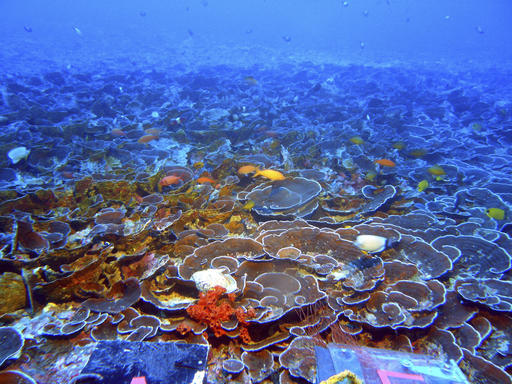Researchers find abundant life in Hawaii’s twilight zone

In this 2009 photo provided by NOAA and the Hawaii Undersea Research Laboratory, fish swim in a mesophotic coral ecosystem about 230 feet deep in the in Au’au Channel off Maui, Hawaii. Coral reefs in Hawaii’s oceanic twilight zone, the deep area of ocean where light still penetrates and photosynthesis occurs, are abundant and home to a wide variety of regionally unique fish species. A paper published Tuesday, Oct. 4, 2016 said that some of the reefs off the archipelago are the most extensive deep-water reef ecosystem ever recorded. (NOAA and Hawaii Undersea Research Laboratory via AP)
HONOLULU — Coral reefs in Hawaii’s oceanic twilight zone, where light still penetrates and photosynthesis occurs, are abundant and host a wide variety of life, a new study shows.
A paper published Tuesday in the journal PeerJ revealed that some of these ecosystems off the Hawaiian archipelago, particularly an area off Maui, are the most extensive deep-water reefs ever recorded.
The ecosystems, found in waters from 100 to 500 feet deep, host more than twice the amount of unique Hawaiian fish species as their shallow-water counterparts, and they are much more extensive than previously known.
“What is unique about this study is how vast and dense the coral cover is,” Richard Pyle, a Bishop Museum researcher and lead author of the publication, told The Associated Press.
Researchers surveyed much of the twilight zone, technically known as the mesophotic coral ecosystem, around the state and found a few hotspots that were particularly productive.
In a channel off the island of Maui, the team said they found the largest uninterrupted coral ecosystem ever recorded, measuring more than three square miles with some areas showing 100 percent coral cover.
Previously, similar reefs in the Gulf of Mexico and off Okinawa, Japan, had been observed, but in much smaller colonies and at shallower depths.
“Although there was a bit of a hint that corals could survive … down at those depths, these reefs off Maui were far and away much more dramatic both because they were deeper and they had higher coral cover percentage,” Pyle said. They covered a “vastly larger” area.
The Maui corals were in an area that combines clear water, plentiful food and shelter from major swells.
While some coral lives in much deeper water, this discovery represents the deepest reef-building species that rely on sun-fueled algae to survive.

In this 2015 photo proivided by NOAA and the Bishop Museum, endemic fishes swim in a mesophotic coral ecosystem near Kure Atoll, the northernmost reef in the Hawaiian archipelago. Coral reefs in Hawaii’s oceanic twilight zone, the deep area of ocean where light still penetrates and photosynthesis occurs, are abundant and home to a wide variety of regionally unique fish species. A paper published Tuesday, Oct. 4, 2016 said that some of the reefs off the archipelago are the most extensive deep-water reef ecosystem ever recorded. (NOAA and Bishop Museum via AP)
The difficulty of exploring depths beyond 100 feet means a large amount of knowledge about coral reefs is derived from those in more shallow water, said Randall Kosaki, deputy superintendent for the Papahanaumokuakea Marine National Monument at the National Oceanic and Atmospheric Administration.
“So the purpose of this study really was to characterize the other 80 percent of their depth range, and see what’s down there,” he said.
The team also discovered an unusually high number of endemic fish species living in some areas, particularly in the Northwestern Hawaiian Islands. There, the team found that nearly 100 percent of the fish species were unique to the region — the highest level of endemism ever recorded in any marine ecosystem on Earth.
It is “absolutely off the scale globally,” Kosaki said. “They are very significant contributions to global biodiversity.”
The team did not document any coral bleaching at those depths, but heat from spiking surface temperatures can penetrate deep into the ocean and cause harm to the fragile habitats.
“There is a time sensitivity to this exploration because due to climate change and other factors we’re at risk of losing species before we even know they exist,” Kosaki said.
The study was conducted over the past 20 years by 16 scientists from NOAA, the University of Hawaii, the Bishop Museum and state agencies.
The researchers contend that the largely unexplored ecosystem requires further understanding and protection.
One theory that they are exploring is something called the “deep reef refuge” hypothesis.
“If shallow coral reefs are more vulnerable to threats from say runoff or overfishing or whatever, then down deep these reefs could potentially serve as refuges for those species,” Pyle said.
But that assumes that the shallow reefs are more vulnerable, and it would only apply to the species that could survive in at both depths, he added.
“We’re not really sure we can jump to that assumption,” Pyle said.
Something that affects the shallow reefs a little bit, such as runoff and murky water, could “potentially extinguish” reefs that survive at the edge of photosynthesis.
“They are incredibly unique, with the higher rates of endemism, they are incredibly rich,” Pyle said. “We should value them every bit as much as we value the shallow reefs.” TVJ














